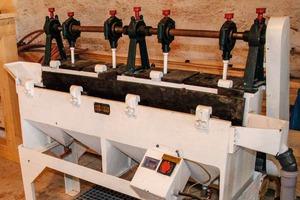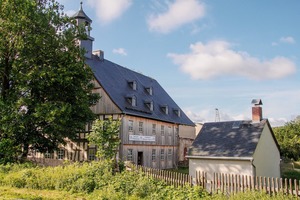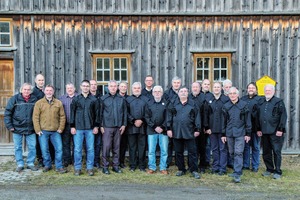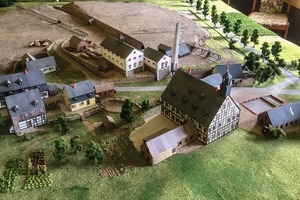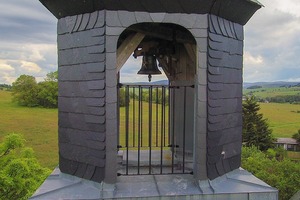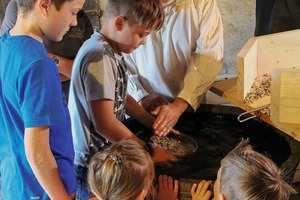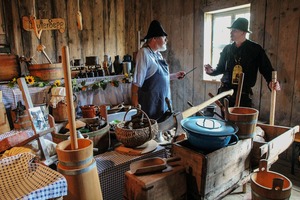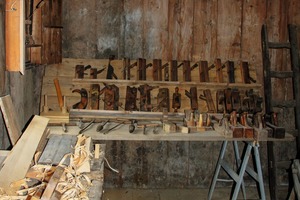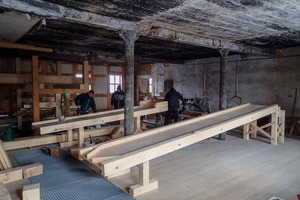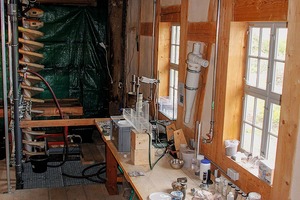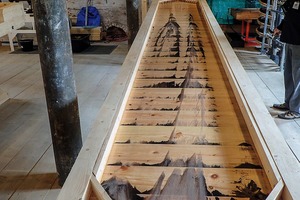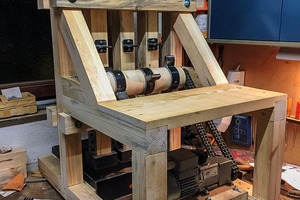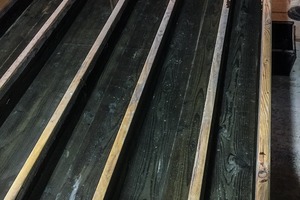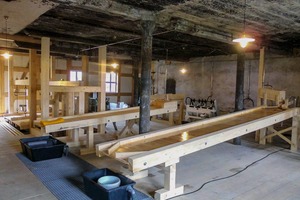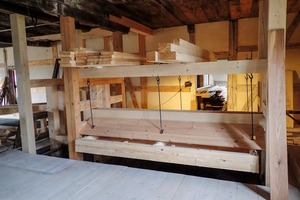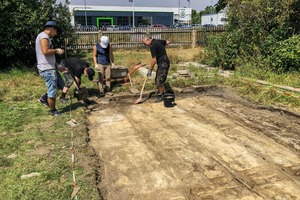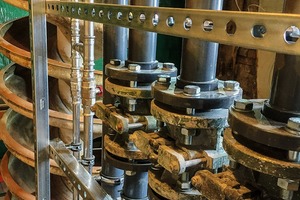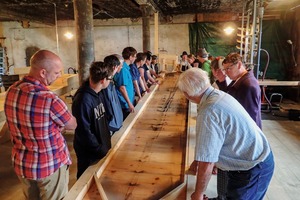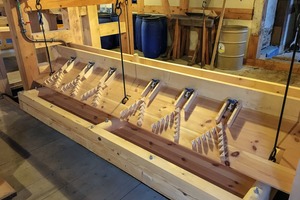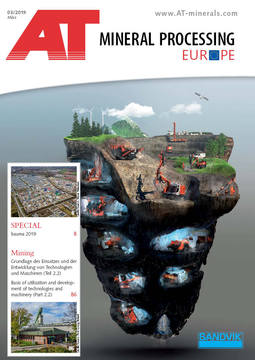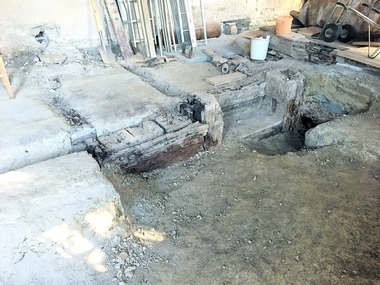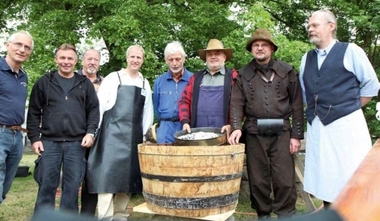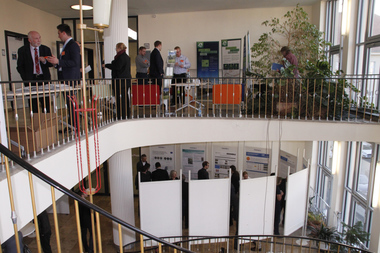Experimental historical ore beneficiation at Wolfgangmassen mine
Besides this purely economic interest, mining can also be viewed in a historico-cultural dimension. An impressive example are the activities of the Bergbauverein Schneeberg/Erzgebirge (Schneeberg/Ore Mountains Mining Society) founded in 1994 with the goal of reconstructing and showcasing the entire process chain of ore beneficiation from extraction in the mine through beneficiation to smelting. The focus is on the process workflows in mineral processing with demonstrations of the different operations.
Established in 1555 originally as a silver mine, besides silver ore, up to the closure of the mine in 1920, cobalt and bismuth ore were extracted at Wolfgangmassen. Thanks to the good sources for the Schneeberg mining area in the archives, the eventful history of Wolfgangmassen Pit has been well-documented with both its times of prosperity as well as decline. From 1780, Wolfgangmassen was regarded as one of the most important mines for cobalt extraction for the production of cobalt blue. The stamp mill with nine rammers driven by an underground water wheel for crushing the ore and ore washery consisting of one vanner and two bumping tables were put into operation in 1818.
The former mine was so well preserved overall at the turn of the millennium that the members of the Bergbauverein Schneeberg/Ore Mountain Mining Society decided to take over the mine site to preserve the decrepit but historically valuable group of buildings. Since then, the members have been reconstructing these buildings with great dedication, making them accessible for the general public.
With the support of sponsors like Nickelhütte Aue, Stadtwerke and Wohnungsbaugesellschaft Schneeberg (Schneeberg municipal works and housing association, respectively) and Bergsicherung Sachsen, since 2003 the society members have realized extensive refurbishment of the stamping mill building built in 1816 – 18. This included the gutting of the building, in places with replacement of the timber framework of both interior and exterior walls, covering of the exterior walls with boards, the complete renewal of the roof structure and roof as well as renewal of the bell tower, which was also fitted with a new bell. The bell of the Wolfgangmassen mine was connected with a clock mechanism and equipped with an hour-striking mechanism. The originally preserved clockwork mechanism, probably built around 1700, was also painstakingly restored and repaired.
Against the background of the efforts of the German-Czech mining region to be recognized as part of the UNESCO world heritage, in 2014 the “Montane Kulturlandschaft Erzgebirge/Krušnohoří” experience days were initiated. Since then, these have been held annually on the first weekend in June, with a large number of events. On this occasion – as well as on the Open Monument Day every year in September or the Museum’s Night in October – the Bergbauverein Schneeberg/Ore Mountain Mining Society presents progress in its activities centring around the Wolfgangmassen mine.
For some years, the focus has been on the refurbishment and building work in the rooms on the ground floor and first floor of the stamping mill so that in future the entire beneficiation chain no longer has to be presented outside, but permanently in the main building. On the first floor, some of the rooms are now used for the historical documentation of the trades related to mining – including the production of tallow for lighting or a carpentry – as well as the presentation of various mine models and portable miniature mine models. In addition, a large function room is available for gatherings, talks and theatre performances.
The ground floor, on the other hand, is devoted to ore beneficiation. The former washery was given a new wooden floor, under this water tanks and a suitable pump system for supply of the water circuits for the wet beneficiation equipment (sizing and sorting) with rain water were fitted. Various equipment has already been rebuilt true to the original or as models by the members of the Bergbauverein according to historical documents. They can be seen alongside mineral processing machines from recent times in operation and enable a comparison with modern processing methods. In addition, a small process engineering laboratory has been equipped to document the processing results. Moreover, it is used to conduct tests according to descriptions in the original documents so as to understand the historical processing details and processes.
In summer 2018, visitors to Wolfgangmassen mine had the opportunity for the first time to actively accompany a large part of the entire processing chain or see it in operation – from crushing of the lumps of rock to a powdery flour, through sorting based on physical properties, e.g. density, to sizing of the material by grain sizes by means of screening or flow forces.
After comminution in the stamp mill, the visitors could personally undertake further sorting of the available material based on density with a jig screen at the jig trough. For mechanical comminution and sorting, there are two models made of wood according to historical details: a dry stamp mill on the scale of 1:3 as well as a launder measuring 6 m in length for wet processing. After the launder, the material was fed to fine sorting in three different grades to a nicking buddle, vanner and side-shake vanner, which were also built 1:1 based on original drawings. For wet sizing, in addition a fully functioning shaking table from the 1950s is available.
On the basis of a detailed description in historical sources from the year 1865 (Jahrbuch Berg- und Hüttenmannn, 1865, p. 109), in late summer 2018, in the scope of Sharing Heritage as part of the European Heritage Volunteers Project with several young people from different countries, a special highlight was exposed directly at the former stamp mill building. A launder measuring around 140 m length, which in its excellent preserved condition is probably the last known installation of its type in the Ore Mountains. In the beneficiation process, it forms an important link between the wet stamp mill and table processing. A launder is generally a trough system – sometimes several hundred-metres-long, which was used in the stamp mills for hydraulic classification and desliming of the ores after wet stamping but before table processing. As still original materials from the time of the closure in the year 1927 can be found in the troughs of the Wolfgangmassen launder, in various tests it was possible to recreate the operation of the launder in combination with table processing. After precise measurement and documentation, the launder was covered up again and lawned over to seal it.
Further processing equipment at the Wolfgangmassen pit includes various screens, a fixed-sieve jig, hydrocyclones and a spiral concentrator. These machines and equipment can be shown in operation. In addition, on display boards, the individual machines are illustrated, and their principle of operation explained. The visitors can therefore not only beneficiate ore themselves, they have the possibility to understand the various methods for recovery based on a comparison of historical and modern processing methods. A bismuth smelting furnace ready for use rounds off the processing equipment at Wolfgangmassen mine.
The Schneeberger Bergbauverein doesn’t limit its activities to above ground. It has also enabled access to a wheel chamber below ground, in which a water wheel with a diameter of 9.6 m used to drive the original stamp mill by means of two rod shafts. Also possible is a short tour through the discharge trench to a water basin for the storage of motive water for a return sprocket turbine, which in turn was used for extraction of the ores in an inclined driving shaft, around 50 m of which is still accessible today. The total flat depth of the Wolfgangmassen pump and driving shaft used to measure a total of 425 m.
Supported by the voluntary work of the members of the Bergbauverein as well as financial and material donations, the Bergbauverein members undertake restoration work on the buildings, research in archives, repair installed machines, rebuild historical machines based on original drawings and look after visitors on site – always with the goal of creating a functioning object to explain ore beneficiation that is unique in the Ore Mountains.
After restoration of the former washery, the Bergbauverein is planning amongst other things to expose the historical stamp mill chamber to install a modified Californian stamp mill in original size. Anyone interested is invited to find out about the work at the mine, to experience a tour of the site and talk to the Bergbauverein members. The Bergbauverein members look forward in 2019 to receiving many interested visitors to the public events and also by separate arrangement. Registrations for the visits are to be made to the Society Chairman Volkmar Müller on tel. no. +49 (0)162 4359984.
Autorin/Author:Ulrike Mehl, Redakteurin/Editor, AT MINERAL PROCESSING

